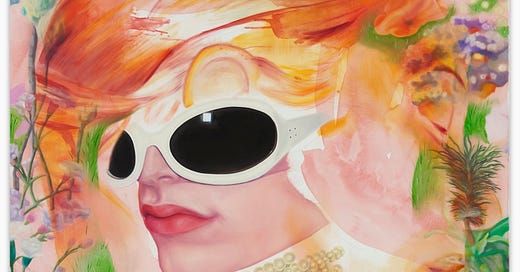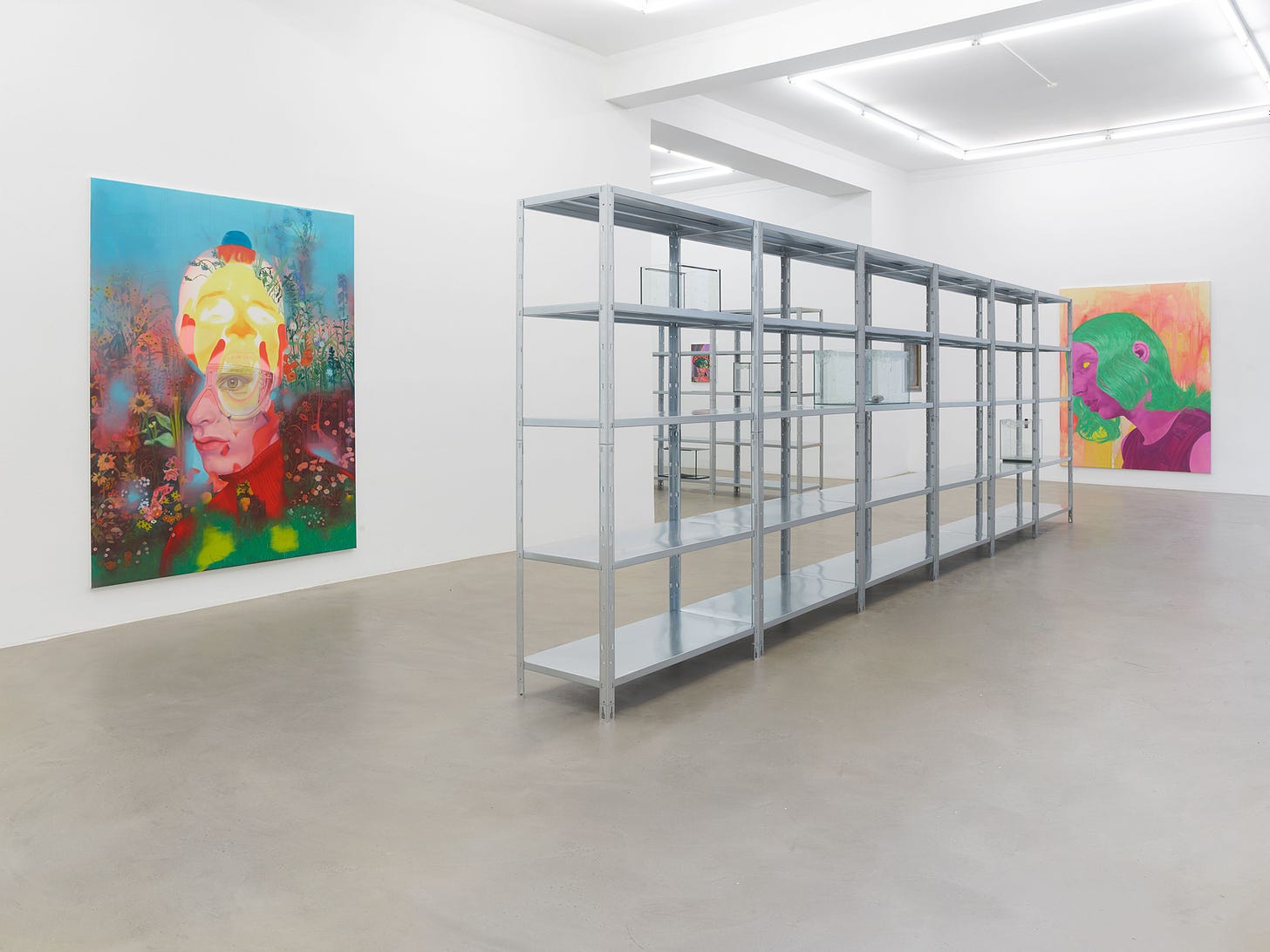Last Chance in March: A picnic blanket, haute couture, and radioactive dreams in Cologne
Spring is finally here and so is the first post of March! Seize your chance to see these three exhibits with unique takes on painting in Cologne before they close this month.
Dragutin Banic: Picknick
Dragutin (Gen X, German) always had an eye for the overlooked things. A rusty pipe on a building, trash cans in a courtyard, a towel tossed into a studio corner. In his paintings, he brings all these little things together.
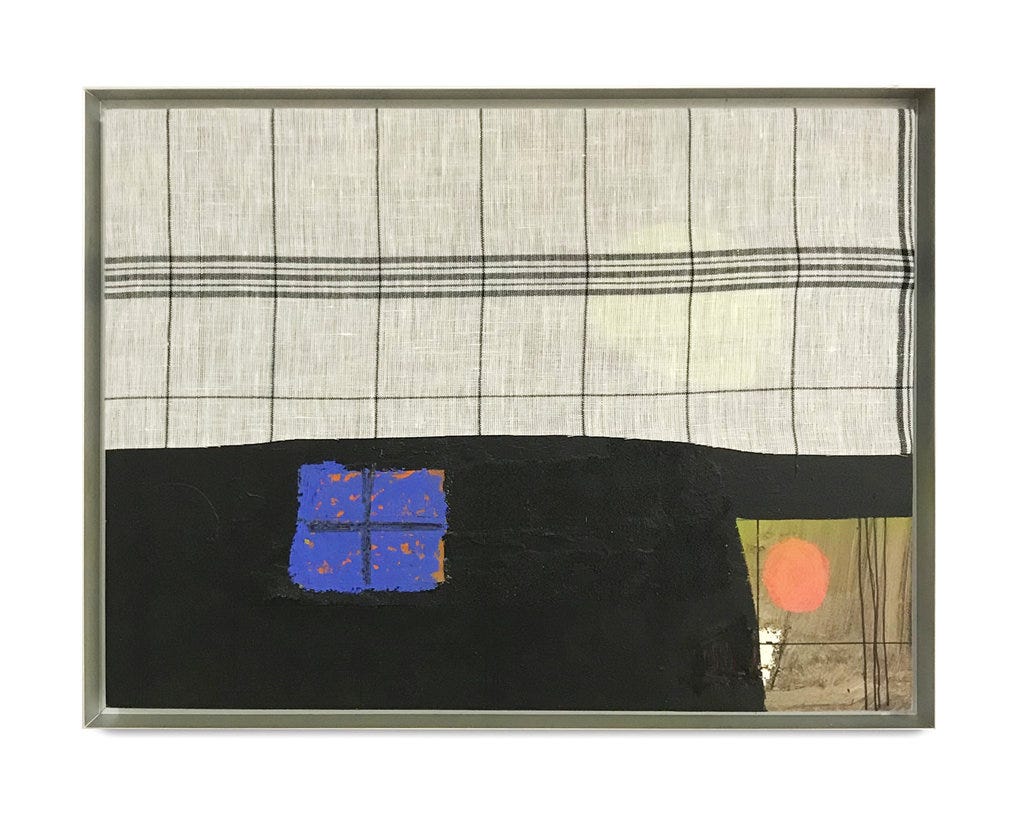
He stretches checkered kitchen towels on a canvas using rabbit glue, paint lurking from underneath and covering the surface. The fabric and canvas combo reminds me of Sigmar Polke (1941-2010, German). Some colorful geometrical shapes sneak out here and there, rebelling against the towels’ neat grid pattern like shattered pieces of a Joan Miró (1893-1983, Spanish-Catalan) mobile. Trash cans and pipes make an appearance as drawings on the cloth. The shaky sketches and hasty lines of Cy Twombly (1928-2011, American) come to mind. In Gelber Nachmittag [Yellow Afternoon] (2023), three teeny tiny barrels peek out physically from the frame. It’s giving Christo & Jeanne-Claude’s Wall of Oil Barrels – The Iron Curtain (Paris) (1962).
Dragutin makes space for a fun chat between materials. Cheap industrial products and tools meet ancient prestigious techniques like painting with raw pigments, oil pastels, and egg tempera on canvas or wood. But not in a visible way. It’s not like Pop Art’s wink at high and low art by making the difference obvious. You wouldn’t notice the techniques if you didn’t know them or see them listed in the check list. It’s much rather an easter egg, if you will.
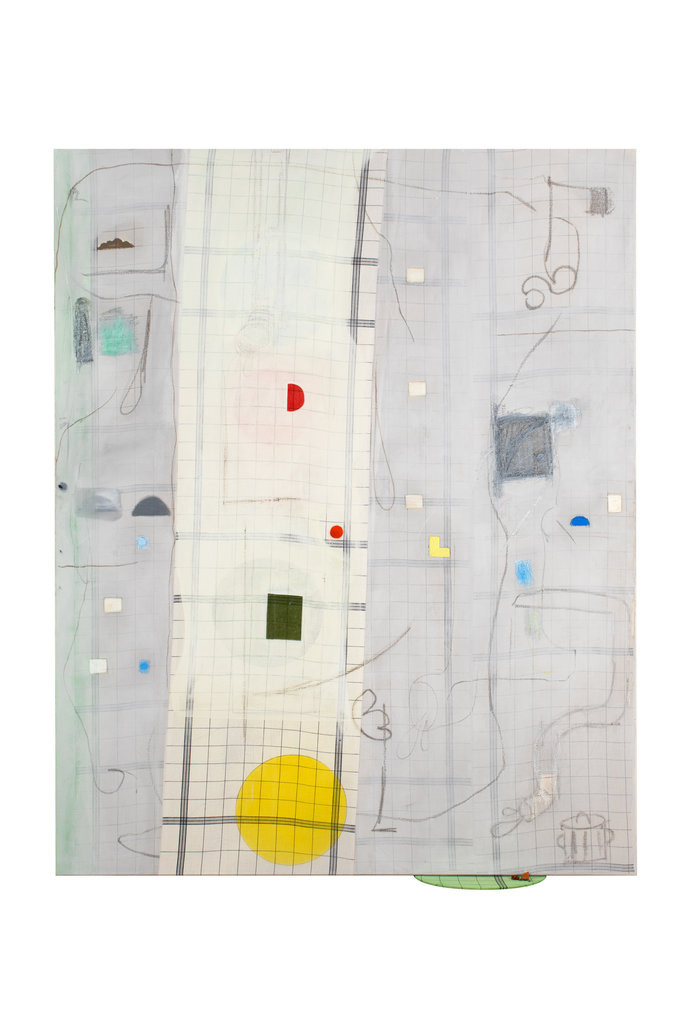
Galerie Martin Kudlek, until March 15, 2024. Schaafenstrasse 25, 50676 Cologne
Kenneth Bergfeld: Animal
Kenneth (Millenial, German) fills his large canvases with haute couture headshots on shrooms. Many wear sunnies. Looks like he browsed through high fashion magazines and put the models into Alice in Wonderland. In reality, Kenneth often paints people from his social circle.
It’s not so much the dreamy flower backdrop that creates this feeling of a psychedelic world but rather the effect of photographic overlay. In Gasoline (2024), the model’s dead stare is the total opposite of the glowing Munchian skull’s horrific scream. The head doesn’t grow out of the other though. Its fluid form isn’t physical. It’s much rather another layer of reality overlapping. The blue tint across the canvas makes the faces look like nothing more than a mirage dissolving. Humans take on an alien form.
Going No Place (2024) layers a red-tinted side profile with enlarged cut-off letters. The canvas becomes the storefront of a designer boutique reflecting the buildings across the street through shattered glass. Riots in Paris? The little optical illusion of glass is so Karin Kneffel (Baby Boomer, German) coded. The sampling of comic slapstick horror elements in Busy Monster (2024) reminds me of fellow painter Jamian Juliano-Villani’s (Millenial, American) trashy takes on pop culture.
The bright magic of Kenneth’s paintings clashes with the steel shelves in the gallery. They’re empty. Except for some fish. Plastic fish. Some lie in an empty calcified tank. Others are hanging around in the corner. But not in a Cosima von Bonin (Baby Boomer, German) way. While the paintings are full of lush colors and drugged imagination, the physical gallery space appears void. The lack of water in the tanks and the fish lying on the floor bring out this idea of something vital missing in this real world.
Jan Kaps, until March 23, 2024. Lindenstrasse 20, 50674 Cologne
Uwe Henneken: Integrity Studies (Painting in a world gone mad)
According to the exhibition statement, Uwe (Gen X, German) “weaves together themes that resonate with the complexity of a modern world, serving as a metaphor for the constant flux that surrounds us from within and without.” Well, thanks for saying so little with so many words. So, what exactly are his works about?
It’s all paintings. There are landscapes. Bright landscapes. In fact, so bright that they might have been snatched from a Rick and Morty episode. I could have said it’s fauvist… Nah, I like the Rick and Morty comparison better. Tree-lined avenues lead into nowhere or a glowing elliptical gate. The bushes and trees are shiny as if drugged up with fluorescent algae or radioactive substances. To me, the hilly landscape in Cave Painting (2022) first looked like it was exposed through a portal ripped open. Then I saw the title. Is this some psychedelic reference to Plato’s Allegory of the Cave or am I tripping?
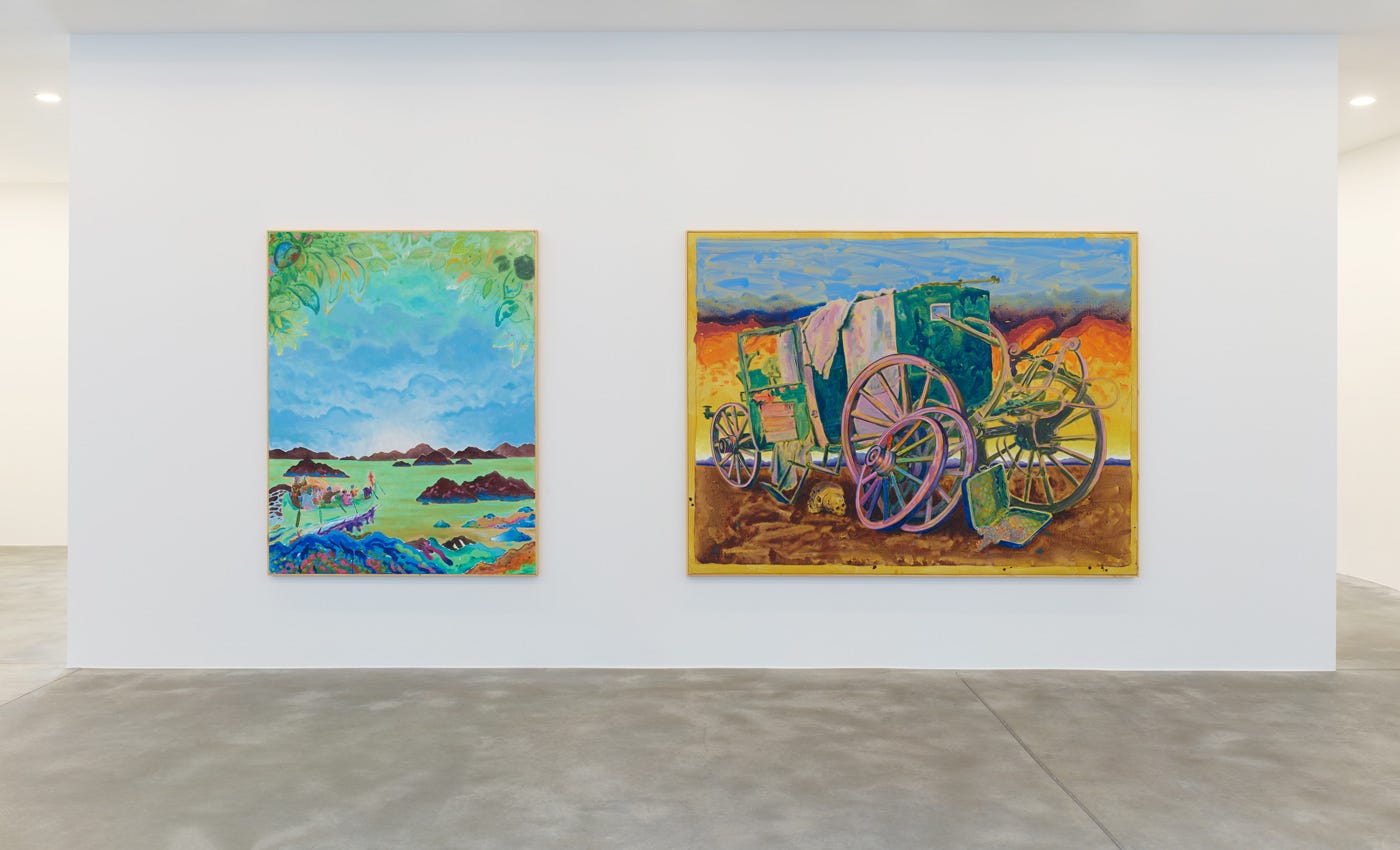
A lot of paintings deal with migration, movement, and change. A queue of dark carnivalesque figures forms serpentine lines in Transformation People (2023). As they progress forward, they morph into light, bright fairy-like beings ascending into the sky before fully dissolving into abstraction.
Uwe also takes visuals from art history and other sources and turns them into something of his own. Looking for Answers, where no Answers can be found (after As the Tide Comes In) (2024) puts the fisherman Gregers, one of the last inhabitants of a small Danish island endangered by climate change, into the center of a majestic sunset (or sunrise?). His overalls appear to reflect some of the sun he’s facing. He takes up space, posing with pride and the elegance of Sandro Botticelli’s Venus (1490).
Finally, Uwe embraces change as he modifies his own paintings (which is common practice in art history, especially for broke artists). Transformation People (2023) is such a changed piece. So is Wheels of Lifes (after Marion Adnams) (2024). Uwe reinterpreted the painting Coloured Ending (1962) by the Surrealist Marion Elizabeth Adnams (1898-1995, British). He took her title literally, assigning one color of the rainbow to each of the rear wheel’s spoke. Marion painted a desolate scene. A broken carriage that is stuck can’t go anywhere. Ain’t no frontier to discover no moe (pls read in a Southern accent). Uwe said double it and give it to the next person by adding two skulls and an open suitcase underneath. But can you even be sad if you make it neon?
Another changed painting, Tree of Life (Tree of Death) (2011-2023) shows two figures embracing a tree amid patches of ochre, yellow, and gold. Respectfully (but maybe not too respectfully if I’m being honest) it’s giving the latest acquisition of Silke and Jochen that reminds them of their 3-week West Africa roundtrip (they will hang it over their leopard sofa next to the “authentic” wooden Gazelle sculpture that Mareike got them last Christmas).
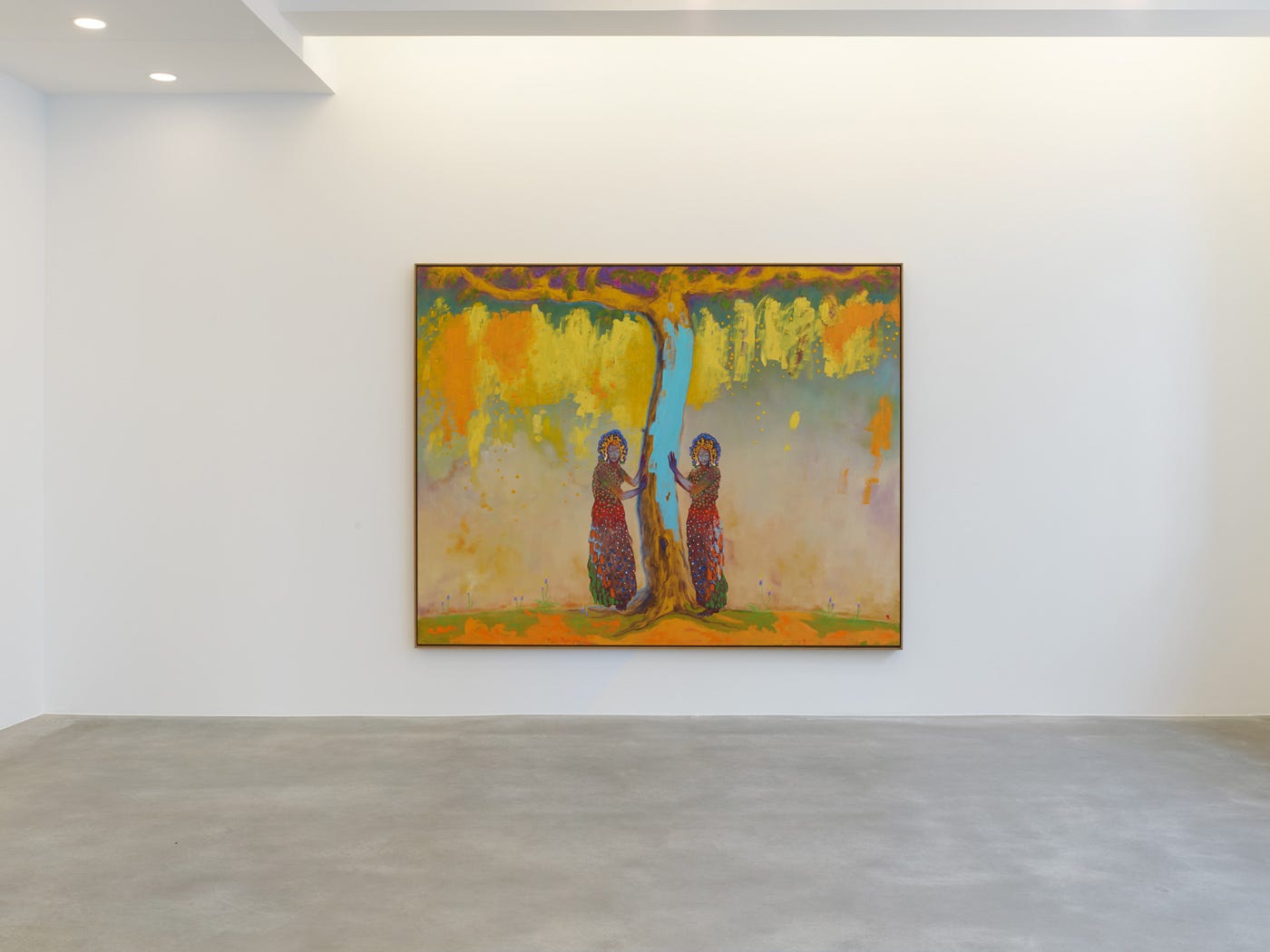
Galerie Gisela Capitain, until March 23, 2024, St. Apern Strasse 26, 50667 Cologne
Stay up to date on exhibits in Cologne by subscribing to my newsletter!
I feel like the less time I have to write, the more honest and blunt my takes get… Let me know your thoughts in the comments! If you don’t feel like saying anything, I always appreciate you leaving a like or sharing with a friend.
See you soon!!!
Jennifer
The Gen Z Art Critic

